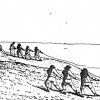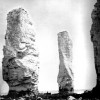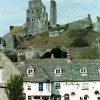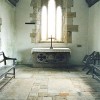SURGEON BY ROYAL APPOINTMENT
With heavy hearts a small band of elderly men stood around a small grave in Dorchester cemetery on a bleak afternoon of wintry drizzle. It was January 1924 and the mourners were paying their last respects to a figure of great philanthropy and achievement, born 70 years before in Dorchester. They watched as a small box of ashes was lowered into the deceased chalky native soil. The man they were saying farewell to was Sir Frederick Treves, one of the most remarkable of men from an age of giants and one of the greatest luminaries in the progress of medicine and surgery.
Treves was born in Dorset’s county town in February 1853; the son of a cabinet maker and furniture dealer who had a business on the premises now occupied by No 8, Cornhill. A housemaid fondly recalled that in his earliest days at school Treves’ shyness led him to hide behind the coats in the cloakroom after lessons. In 1860 however, he began attending a school run by the poet and Rector of Winterbourne Came, William Barnes, in South Street.
His famous pupil remembered Barnes as: “…an old clergyman of great courtliness, ever gentle and benevolent, who bore with supreme simplicity the burden of a learning, which was almost superhuman.” Thomas Hardy, who’s family lived only a few miles from William Treves’ furniture shop, early became an inevitable acquaintance; it was a friendship which would last for the rest of young Frederick’s life.
Upon the death of his father William, Treves’ mother Jane sold the shop and moved with her children to London. After attending the Merchant Tailors School and University College, Treves with his two elder brothers embarked upon a medical career. In 1871 he became a student at the London Hospital, where his hard work and dedication saw him rise to become Licentiate of the Society of the Royal College of Surgeons.
In 1877 Treves married Elizabeth Mason, a brewers daughter. That year he joined a GP practice in Cheshire, but soon after fell out with the senior partners over their objections to his suitability to attend the confinement of an upper class socialite. For Treves, the social caste of the baby to be delivered matter not at all, but the principle did. He threw up his practice and returned to London in 1879, living first in Sydenham.
From this time he held a succession of posts over the next 20 years. He became an authority on anatomy and surgery, specialising in the abdomen. On one occasion he wrote to The Lancet urging the importance to public health of the registry of disease by hospitals. He was an effective lecturer, able to communicate well with both academics and undergraduates, and encouraged his students to take notes in the wards as well as in lectures. He also founded the Students Union at the hospital.
One of the several curious and unusual cases of his career during these years came when he was summoned to the home of the American millionaire J.P. Morgan. A new-born baby in the Morgan family was evidently dying from an undetermined cause, which baffled all the specialists present. After examining the baby Treves had to admit that he too was baffled by the condition until a second examination revealed the head of a needle which had penetrated the heart. After seeking permission to perform a dangerous operation Treves opened the child’s chest and removed the needle. As he later stated: “..there was only one thing to do: make a grab for it. If I got it there was some hope. If I missed…. but I got that needle!.”
In 1884, Treves encountered Joseph Merrick, a man born with a hideous deformity of the face caused by an abnormal accumulation of spongy tissue, which also included a curious of the nose, so earning him the name of Elephant Man. At that time a travelling showman, an indignity that incensed Treves and led him to rescue the accursed man from his showman master, was exhibiting Merrick for profit as a side-show freak.
He was examined, but Treves was only able to offer minimal treatment. The physician had to rely entirely upon his kindness and humanity in offering Merrick a better life, which he did by taking him to the Dury Lane Theatre and to visit Princess Alexandra.
Treves later wrote, “…I suppose Merrick was imbecile from birth. The fact that his face was incapable of expression, that his speech was a mere spluttering, and his attitude that of one who’s mind was void of all emotions and concerns gave grounds for this belief. It was not until I came to know that Merrick was highly intelligent, that he possessed an acute sensibility and a romantic imagination that I realised the overwhelming tragedy of his life.”
On another occasion he attended Sir Henry Irvine after the great actor had accidentally swallowed the nozzle of a throat spray. Treves examined Irvine and then had x-rays taken, but on his second visit the doctor discovered that his patient had coughed up the nozzle and needed no surgery to remove it.
Treves left the hospital in 1897 to concentrate on private practise and to develop a career as a writer. Upon the outbreak of the Boer War he was appointed consulting surgeon to a South African field hospital. Here Treves found himself defending the Royal Army Medical Corps against criticism that it was dealing inadequately with sickness. This in turn drew criticism upon himself, though he was active in pressing for improvements. One case in particular during this conflict that would leave a lasting impression in Treves’ mind, and one of many demonstrations of the depth of his human understanding, was his deathbed comforting of Frederick Roberts, son of Lord Roberts of Pretoria, who had been mortally wounded during the battle of Colenso.
In the winter after the soldier’s death Treves upon visiting the grave, found that the heat had drawn Robert’s stark corpse from the ground. The doctor – entirely alone – re-interred the body himself. In 1900, before the end of the war Treves’ services in South Africa were recognised in Dorchester when he was made a Freeman of the Borough. In 1903 he opened an operating theatre in the County Hospital.
But the act of duty he is best remembered by came in 1901, when he was appointed to operate on the as yet uncrowned Edward VII for peritonitis. Treves recalled how, to allay public suspicions that anything was wrong with the King on the eve of his coronation, he was allotted a code number, alias and casual disguise, even disembarking from the train at the previous station and walking the rest of the way to the royal residence.
After the operation Treves joined the King on the royal yacht. In gratitude for literally saving his life Edward made the surgeon a Baronet, Knight Grand Cross of the Victorian Order and gave him a grace and favour house, Thatched House Lodge in Richmond Park. It was here that he was once visited by his great friend and fellow countyman, the Cassells publisher Newman Flower, about a matter of publication. Flower lovingly recalled in his ‘Just as it Happened’ how he found every chair but one in the living room piled high with papers which, upon enquiring, discovered were the pages of an Italian dictionary the doctor was compiling, but which was never published.
In 1904 Treves retired from surgery to concentrate on travel and writing books, medical papers and letters to The Times. That year he also undertook a visit to Japan, where he was presented to the Emperor, an event, which inspired one of his greatest works ‘The Other Side of the Lantern.’ On a later occasion he also met the President of the USA. In the summer of the following year (1905) he made a phenomenal blanket cycle tour of every settlement in Dorset, which became the raw material for his ‘Highways & Byways of Dorset’ (1906.) The retired doctor wrote vividly of his impressions of what he saw in the countries he visited, and in one of his letters to the Times expressed his reservations about the nature of the restoration work being carried out on Puddletown Church.
He held the first presidency of the Society of Dorset Men in London, standing down three years later to make way for Thomas Hardy, though he continued to contribute several articles to its Yearbook thereafter, including ‘William Barnes the Dorset Poet’ and ‘Dorset Seventy Years Ago.’
Treves was a humanitarian, a man intolerant of humbug or deception. He was never slow to temper at any injustice yet had great reserves of kindness and compassion. He did not mince his words over matters, which animated or angered him, such as the standard of medical care in hospitals. During his hospital years in London he could still find time to put in an hour or so of writing each morning before his daily work on the wards began. He was a genius of surgery, yet found time to pursue a wide range of other interests. He was keen on sailing and gained a qualification certificate as a Master Mariner. He is said to have sailed the Channel to France and back every Boxing Day. His coterie of friends included many famous men of books and letters such as Edmund Gosse, Thomas Hardy, William Watkins and William Barnes.
After the First World War failing health led Treves to spend most of his time on the Continent, first at Monte Carlo, then Vevey near Lausanne. Here he was visited by Newman Flower, who encouraged him to write ‘The Elephant Man & Other Reminiscences,’ the book which more than any other documented the extraordinary casebook of his career and his distinguished clientele. Other works were ‘The Lake of Geneva’ and ‘Tale of a Field Hospital.’ On a visit to England in November 1923 he joined Newman Flower for a dinner in London in the company of Edmund Gosse. It was the last time the trio of friends would ever meet up together. In the first week of December that year Treves went up the hill above Montreux to watch a football match. Possibly aggravated by the weather, the great surgeon was taken ill with peritonitis upon his return and after several days in a state of delirium he died in the hotel at Vevey.
William Watkins, who had founded The Society of Dorset Men in London, arranged the funeral in association with Thomas Hardy. But the ceremony had to be postponed twice because of bad weather on the Continent and a delay caused by having to produce the death certificate. After the funeral Newman Flower returned to have tea with the Hardy’s.
Later Lady Treves approached Flower with the suggestion that he should write the official biography of her husband, but the widow later had second thoughts about allowing Treves’ court connection to be publicised and withdrew the request. Since then no biography of Sir Frederick Treves has ever been written.



